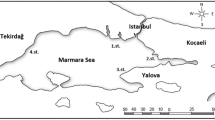Abstract
The muscles of some important marine fishes collected in and around Hooghly estuarine coastal areas were analyzed for the heavy metals Cu, Zn, Ni, Cd, Cr and Pb. The concentration range of Cu (16.22–47.97 ppm), Pb (12.40–19.96 ppm) and Zn (12.13–44.74 ppm) were recorded comparatively higher and were similar to that found in contaminated areas. On the other hand the ranges of Ni (2.20–3.69 ppm), Cr (0–3.89 ppm) and Cd (0.62–1.20 ppm) were almost equal to those carried out over a wide range of geographical areas. The degree of bioaccumulations was metal-specific as well as species-specific in nature. The toxic groups of metals (Pb and Cd) showed higher variability than the essential metals (Cu, Zn and Ni). The calculated intake value of metals (week−1 kg−1 body wt) varied from 14.88 to 27.60 of Pb, 0.87 to 1.68 of Cd, 0.0 to 5.45 of Cr, 22.70 to 137.16 of Cu, 3.08 to 5.17 of Ni and 16.98 to 62.60 of Zn through human consumption of these fishes and were compared with those of standard Provisional Tolerable Weekly Intake value (PTWI) per kg body weight as stipulated by WHO. The PTWICal values of Pb in some of the fishes recorded marginally excess values and may indicate a health risk through consumption of successive 7 days in a week.

Similar content being viewed by others
References
Ahmed HAH, Naim SI (2008) Heavy metals in eleven common species of fish from the Gulf of Aqaba, Red Sea. J Biol Sci 1:13–18
Bruce AF, Rimmon CF, Richard LW, Robert DW, William FG (1975) Levels of toxic metals in marine organisms collected from Southern California coastal waters. Environ Health Perspect 12:71–76
Chandra K (1999) Status of heavy metals and pesticides in aquatic food chain in context of Indian rivers, Summer School on Ecology, Fisheries and Fish Stock Association in Indian Rivers, CIFRI, Barrackpore, pp 92–98
CSE (2003) A refreshing guide to food safety. Down to Earth, December, pp 27–36
Ganguly D, Dey M, Mandal SK, De TK, Jana TK (2008) Energy dynamics and its implication to biosphere–atmosphere exchange of CO2, H2O and CH4 in a tropical mangrove forest canopy. Atmos Environ 42:4172–4184
Ghosh PB, Chowdhury A (1989) Cu, Zn and Pb in the sediments of Hooghly Estuary. Environ Ecol 7:427–430
Goldberg ED, Koide M, Hodge V, Flegal AR, Martin J (1983) US Mussel Watch: 1977–1978 results on trace metals and radionuclides. Estuar Coast Shelf Sci 16:69–93
Louma SN (1983) Bioavailability of trace metals to aquatic organisms, a review. Sci Total Environ 28:1–22
Millennium Ecosystem Assessment (2005) Ecosystem and human well-being, synthesis. Island Press, Washington
Miretzky P, Saraleguy A, Cirelli AF (2004) Aquatic macrophytes potential for the simultaneous removal of heavy metals. Chemosphere 57:997–1005
Mitra A, Chowdhury A (1993) Trace metals in macrobenthic molluscs of the Hooghly estuary, India. Mar Pollut Bull 9:521–522
Moore JW, Ramamoorthy S (1984) Heavy metals in natural waters. Applied monitoring and impact assessment. Springer, New York, p 268
Mukherjee M, Kashen A (2007) Sundarban wetlands. Department of Agriculture, Aquatic Resources and Fishing Harbours, Govt. of West Bengal, West Bengal, p 159
Nies DH (1999) Microbial heavy metal resistance. Appl Microbiol Biotechnol 51:730–750
Reddy MS, Mehta B, Dave S, Joshi M, Karthikeyan L, Sharma VKS, Basha S, Ramachandriah G, Bhatt P (2007) Bioaccumulation of heavy metals in some commercial fishes and crabs of the Gulf of Cambay. India Curr Sci 92:1489–1491
Sarkar SK, Bhattacharya B, Debnath S (2002) Heavy metal concentration from biota of Sunderban mangrove ecosystem. Aquat Ecosyst Health Manage 5:467–472
Walker CH, Hopkin SP, Sibly RM, Peakall DB (1996) The fate of metals and radioactive isotopes in contaminated ecosystem. In: Principles of ecotoxicology, Taylor and Francies, London, pp 51–72
Wood JM (1974) Biological cycle for toxic elements in the environment. Science 183:1049–1052
Zehra I, Kauser T, Zahir E, Imam Naqvi I (2003) Determiantion of Cu, Cd, Pb and Zn concentration in edible marine fish Acanthopagurus Berda (Dandya) along Baluchistan Coast-Pakistan. Int J Agri Biol 5:80–82
Acknowledgments
Two authors (S. Das and R. Ray) are indebted to the Department of Science and Technology, New Delhi and Department of Environment, Government of West Bengal, India, for providing fellowships. Authors are thankful to anonymous referees for their thoughtful and constructive comments on the earlier manuscript.
Author information
Authors and Affiliations
Corresponding author
Rights and permissions
About this article
Cite this article
De, T.K., De, M., Das, S. et al. Level of Heavy Metals in Some Edible Marine Fishes of Mangrove Dominated Tropical Estuarine Areas of Hooghly River, North East Coast of Bay of Bengal, India. Bull Environ Contam Toxicol 85, 385–390 (2010). https://doi.org/10.1007/s00128-010-0102-1
Received:
Accepted:
Published:
Issue Date:
DOI: https://doi.org/10.1007/s00128-010-0102-1



